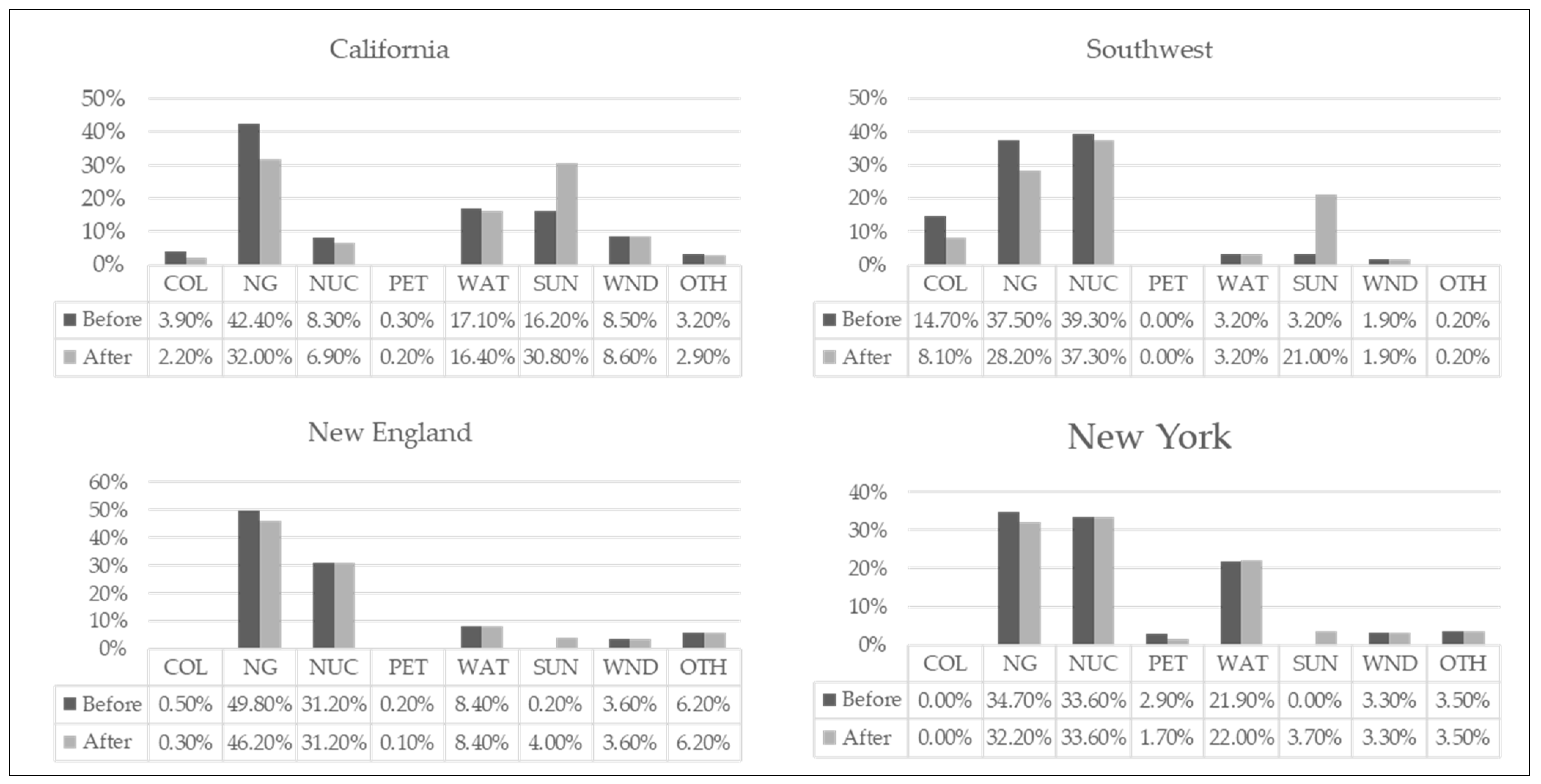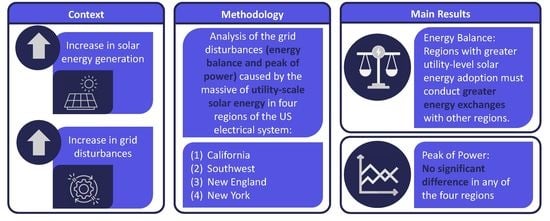4.1. Results at Different Levels of Solar Energy Penetration
Table 3 shows the before and after of adding hypothetical solar plants, considering a solar energy penetration of 100%. In
Table 3, it is observed that the California region generates the highest percentage of solar energy with 16.2%, followed by the Southwest region with 3.4%. On the other hand, New England only generates 0.2% of solar energy, and the New York region does not have solar generation. This reflects the different levels of solar generation considered in the study. Also,
Table 3 shows that the primary energy source in California, New England, and New York is natural gas, with 42.4%, 49.8%, and 34.7%, respectively. In the Southwest region, the main energy-generation resources are nuclear (39.3%) and natural gas (37.5%). The generation from coal and petroleum products, the largest carbon emitters, are less than 4% in California, less than 1% in New England, and less than 3% in New York. However, in the Southwest, the generation from coal reaches almost 15%, being the third most used source, and the generation from petroleum products is zero. This demonstrates that each region has a different energy matrix, with various levels of fossil fuel use.
Table 3 also shows the results with 100% hypothetical penetration of solar energy. Solar generation almost doubled from 16.2% to more than 30% in the California region. With this increase, solar generation becomes the second source of energy. In the case of New England, where solar generation was only 0.2%, it increased to 4%. This implies that the increase in solar generation helped reduce the consumption of fossil fuels in the New England area. The New York region had no solar generation. However, after the incorporation of 100% of the hypothetical solar plants, it reached a solar generation of 3.7%. The second area with the highest solar generation, the Southwest region, increased from 3.2% to 21%. This implies that Southwest has tremendous potential for solar generation (Arizona, New Mexico, and Southern Nevada).
Table 4 shows the solar generation in each region, and by source, with a penetration of 75%. Even with a 75% penetration of solar energy in the California area, solar energy is the second most used source. Solar energy remains the third most widely used source in the Southwest region. It is essential to mention that even with a 75% penetration, it is still possible to reduce use of fossil fuels significantly. For example, the use of coal in the Southwest decreased from 14.7% to 8.3%. In New England, coal and oil products were cut by almost half. Solar generation becomes the third renewable energy source in the New York region, below hydropower and wind. This implies that even with a 75% penetration of solar energy, a significant reduction in the use of fossil fuels can be achieved in the analyzed regions.
Table 5 shows the results in the energy balances before and after the incorporation of hypothetical solar plants, with a 50% penetration of solar energy. While in California and the Southwest solar power generation remains the leading renewable source, in the New England and New York regions, it is the third-largest renewable source behind hydro and wind power. With 50% solar energy penetration, the New England and New York regions only have 2.1% and 1.8% solar generation, respectively. In the Southwest region, there is still a significant decrease in the generation of coal, from 14.7% to 8.7%. This implies that by reducing the penetration of solar generation to 50%, the impacts on the grid are less significant, particularly in New York and New England.
Table 6 shows the generation by region and source considering a 25% penetration of integration of photovoltaic generation plants. Solar generation in the California area reaches 19.9%, more than 10% less when compared with 100% penetration of solar energy. After hypothetical solar plant integration, solar generation in the New England and New York regions is about 1% higher than baseline. In the Southwest region, solar generation remains the main source of renewable energy, being 7.7% higher than hydropower (3.2%), and wind (1.9%). This implies that the reduction in fossil fuel use is noticeably less than the other scenarios (higher percentage of solar power generation), particularly in New York and New England, which have the smallest percentage increases in solar power generation.
4.2. Results of t-Test for Each Hypothesis
Table 7 shows the results of the equal means
t-tests when comparing net generation before and after incorporating the solar plants.
Table 7 details the results of Hypothesis 1 by region and solar energy penetration level. Only one
p-value in the Southwest region with 100% solar energy penetration is significant (
p < 0.05). The rest of the
p-values are not significant (using
p < 0.05), which means that the null hypothesis is not rejected and that there is no evidence to establish that the means are different. The Southwest region had the most significant increase in solar power generation, from 3.2% to 21.0%. The substantial increase in solar generation resulted in a difference in means when considering 100% penetration of solar energy. However, when reducing the percentage of solar energy penetration, there is not enough evidence to reject the null hypothesis that the means are equal. On the other hand, it is observed that in the four regions, California, New England, New York, and Southwest, as the penetration of solar energy decreases, the
p-value of the statistical test increases. This implies that the equality of the means fails to be rejected as the percentage of the solar penetration decreases. Another important insight from the table is that of the regions analyzed, California produces the most energy on average, followed by Southwest, New York, and New England.
Table 8 shows the results of Hypothesis 2 by region and level of solar penetration. This part of the analysis shows that when comparing the difference between net generation and demand before and after incorporating the hypothetical solar plants, there is evidence to reject the null hypothesis in the California and Southwest regions. Particularly in the California area, when considering 100% and 75% solar energy penetration, the
p-value is less than 0.05, so there is evidence to establish a significant difference between the means (net generation—demand) when comparing before and after incorporating the hypothetical solar plants. In the Southwest area, when solar penetration levels of 100%, 75%, and 50% are considered, there is evidence to reject the null hypothesis (
p < 0.05). This implies that the means of the difference between net generation and demand before and after incorporating solar plants are different. On the other hand, in the New England and New York regions, at all levels of solar energy penetration, none of the
p-values is significant (
p < 0.05), which means that the null hypothesis is not rejected and that there is no evidence to establish that there is a difference between the means (difference between net generation and demand).
Table 9 shows the results when comparing the absolute error of the difference between net generation and demand before and after incorporating the solar plants into the system. The
p-values of the analyses carried out to test Hypothesis 3 of the study indicate a significant difference (using
p < 0.05) between the means in the California and Southwest regions. In the California region, for penetration levels of 100% and 75%, a
p-value of less than 0.05 was found. This means that the absolute value of the difference between net generation and demand is different when comparing before and after the massive integration of solar plants. In the case of the Southwest area, a significant difference was found in the means (
p < 0.05) for penetration levels of 100%, 75%, and 50% of solar energy. In the New England and New York regions, the
p-values are greater than 0.05, so the null hypothesis cannot be rejected. This implies that based on the given data, there is no strong evidence to suggest that the absolute value of the difference between the net generation and demand is not different.
Additionally, it is observed that the p-values in each of the regions increase with increasing levels of solar energy penetration. This means that the massive integration of solar energy impacts the absolute value of the difference between net generation and demand. In other words, solar energy affects the energy interexchange between balancing authorities in absolute value.
Table 10 shows the results associated with Hypothesis 4 by region and level of solar energy penetration. Hypothesis 4 analyzes the peak energy, considering net generation as a variable before and after integrating solar plants into the system. As a result, it is recognized that the daily peak of energy does not have a statistically significant difference (at
p < 0.05) when analyzing the net generation. However, it can be observed in the table that as the penetration of solar energy decreases, the
p-value increases. This implies that the greater the penetration of solar energy, the greater the probability of increasing the power peaks in the balancing authorities.
Finally,
Table 11 shows the results when the energy peaks of the difference between net generation and demand are analyzed before and after the integration of solar plants. As a result, the null hypothesis is not rejected in the four analyzed regions, California, New England, New York, and Southwest. This means that the difference between net generation and demand before and after the massive integration of solar plants is not different. These results are explained due to the high mean value in the baseline of the difference between net generation and demand (the exchange of energy between balancing authorities). From
Table 8, it can be seen that, for example, in California, there are exchanges of almost 8000 MW, in New England and New York of more than 2500 MW, and in Southwest of nearly 6000 MW on average. This implies, as the difference between net generation and demand is significantly high, the impact of solar energy generation is much smaller.








